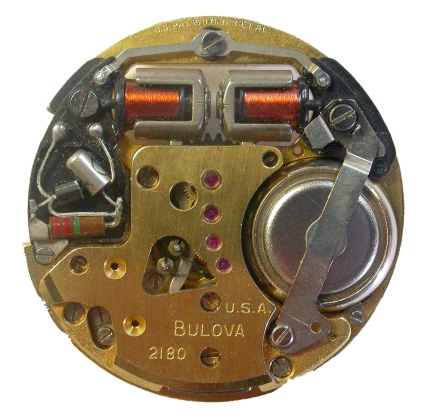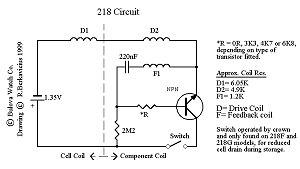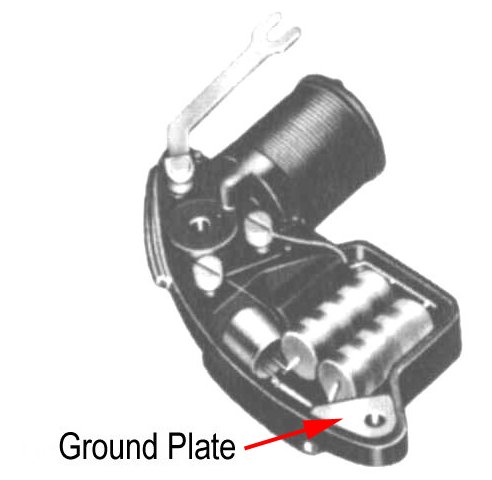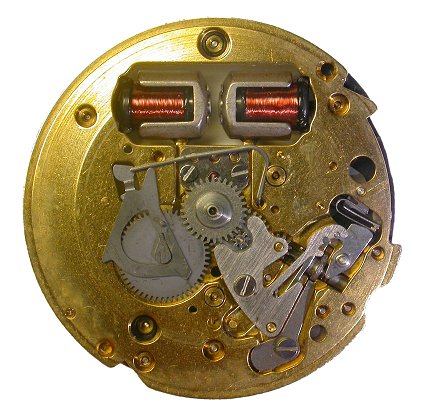

 |
 |
| 218 front (dial side) view. | 218 back view. |
| Manufacturer: | Bulova Watch Company Inc. |
| Dimensions: | 29.7mm x 4.9mm |
| Commencement of Manufacture: | 1965 |
| Tuning Fork Frequency: | 360 Hz |
| Index Wheel: | 320 teeth |
| Derived Calibres | 218D, 2180, 2181, 2181F, 2181G, 2182, 2182F, 2182G, 2183, 2183F, 2183G, 2185, 2186, 218S, 218SC, Citizen calibres 3700, 3701, 2701B, 3702, 3710, 3711, 3721. 3722. |
The Accutron 218 would probably be the most common type you will find. It is an excellent movement, both for its functionality and also relative ease of repair (by watch-repair standards that is). It can be found with a great variety of case styles and dials. Just looking at the list of derived calibres above shows that Bulova really got everything right with this design. Many of the versions of this calibre are seen as variations of the date and day function. 12 and 24 hour versions are also seen. A couple of very collectible versions are the "Astronaut" I and II, on which it is possible to change the hour-hand indication without disturbing the time displayed.
The 218 electronics are very similar to the 214. They have changed they way the feedback is applied to the transistor, and have made provision for a resistor in series with the transistor "base" pin. This is to allow for different types of transistors to be used. depending on what they could get at the time.
 |
| Click to enlarge |
There are two variations from the original 218 to the electronics and "hack" mechanism. The "hack" mechanism is the device which stops the watch when the crown is pulled out for time-setting. Below is a standard 218, made in the USA.

| 
|
| Std 218 Component Coil | Std. 218 Pillar Plate |
The pics above shows the component coil assy for a standard 218 (ie 2180, 218D, 2181, 2182). The ground plate is indicated by an arrow, because changes were made to this in other 218's. The ground plate on these models has a permanent electrical connection to the pillar plate by a screw, which also acts as a mounting screw. When the watch crown is pulled out, a small pin attached to a lever (the Hack Lever) lifts the pawl finger slightly off the index wheel, stopping the watch. The electronics continue to function as per normal and the fork keeps humming. When the crown is pushed back in, the pawl finger re-engages the index wheel, which begins to turn again. Simple and effective.

| 
|
| Model 2180F Pillar Plate | Model 2180F contact switch |
This version still has the standard component coil assy, however, the pillar plate hole which receives the ground-plate screw has been replaced by an insulated bush. Thus the screw is now isolated electrically from the pillar plate. The standard ground screw is replaced by a longer gold-plated one which has a tip that projects through the other side of the pillar plate and insulated from it. This forms one of a pair of contacts. The other contact is made of a gold-plated spring which is attached to the pillar plate. These contacts are operated by the setting lever. The design of the moving contact seems to me to be a bit "back yard". It is crimped into the pillar plate, and if it should break, the the entire pillar plate would have to be replaced. See pics above.
The effect of this contact mechanism is to form an electrical disconnect switch to stop all current flow when the crown is out. This means the watch could be stored in setting position, without draining the battery.
But there is more....Bulova also replaced the hack pin with an adjustable collett, which touches and instantaneously stops the tuning fork from vibrating. I am mystified why they did this. The only reason I can think of is that they decided that lifting the pawl finger was not such a good idea, as it might change the pawl finger tension slightly and thus affect the watch accuracy - maybe. Alternatively, they may have thought it was too hard to adjust. However, 25-35 years later, who can say whether this was really a problem. There are thousands of standard 218's with normal hack pins still out there humming away just fine. Anyway, it seems that Bulova decided it wasn't that great an idea either, because on the 218G, they went back to the old style hack pin.

| 
|
| Model 2182G Pillar Plate | Model 2182G contact switch |
The Model 218G and its variations was made by both Bulova and the Citizen Watch Co. in Japan. Bulova owned a large share of Citizen between 1970 and 1975. Citizen supplied parts to Bulova during these years. For what models I am not sure, but at least for the 218 and probably 219. The 218 parts are perfectly interchangeable between the Japan and USA built movements, and the level of finish is identical. The Japanese built 218's can be identified by the stamp "Lic. Bulova" instead of "US Pat xxxxxxxxxx et al". This can be found at the very top edge of the mainplate, between the two coils. With this model, Bulova changed the hack system again. They dropped the idea of the stop collett on the hack lever, and went back to the old hack pin idea, which as before, lifts the pawl finger off the index wheel. The component coil assembly was modified again from the standard type, and the ground plate was deleted. Instead, a contact plate was fitted to the underside of the plastic molding, and this projected through a hole machined in the pillar plate. The original ground screw position was retained, but its only purpose was to serve as a mechanical mounting point.
In this new machined hole in the pillar plate, a contact spring was fitted (different to the 218F type). These two contacts were operated by the setting lever (modified yet again to suit). Also, the setting lever now has 3 positions, ie, the crown has 3 positions - in, middle and out. In the in position, the watch runs normally. In the middle position, the hack works, and the watch can be set. In the fully out position, the battery is disconnected, suitable for storage.